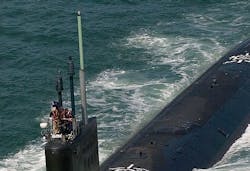Navy asks Lockheed Martin subsidiary to upgrade multi-band communications submarine antenna
Officials of the Space and Naval Warfare Systems Command (SPAWAR) in San Diego announced a $30.9 million contract to Sippican/GSM Submarine Antenna to develop an OE-538B antenna upgrade, as well as to provide OE-538 and OE-538A antennas for Navy submarines.
The OE-538 antenna system is a submarine mast-mounted, multi-function antenna that enables submarines to communicate on radio frequencies ranging from very low frequency (VLF) to ultra high frequency (UHF), as well as provide identification, friend or foe and Global Positioning System (GPS) capabilities.
The contract provides for existing and upgraded capabilities to the OE-538 antenna system, which is applicable to all submarine classes. Sippican/GSM Submarine Antenna operates as a subsidiary of Lockheed Martin Sippican Inc.
The OE-538A antenna system is a modified OE-538 antenna system with added capabilities to support Mobile Users Objective Systems Tactical Data Link via Link 16 and iridium capabilities. The OE-538B antenna will be a modified OE-538A antenna with added capabilities for anti-jam and GPS military-coded capabilities.
Related: Real-time submarine communications at speed and depth takes another step toward deployment
The OE-538/BRC is a mast-mounted communication and navigation antenna for new submarines, or as a replacement upgrade for antennas on existing submarines.
It supports VLF/LF receive (10 to 170 kHz), MF/HF transceive (2 to 30 MHz), VHF line-of-sight transceive (30 to 174 MHz), VHF/UHF transceive (225 to 400 MHz), VHF/UHF SATCOM transceive (240 to 400 MHz), IFF transpond, and GPS receive.
When used for satellite communications, the antenna is capable of full duplex UHF Demand Assigned Multiple Access (DAMA) communications with UFO and MILSTAR (LDR) satellites.
The contract has options that could bring its value to $68.9 million. Sippican/GSM Submarine Antenna will do the work in Marion, Mass., and should be finished by August 2018.
For more information contact Lockheed Martin Sippican online at www.sippican.com, or SPAWAR at www.spawar.navy.mil.
